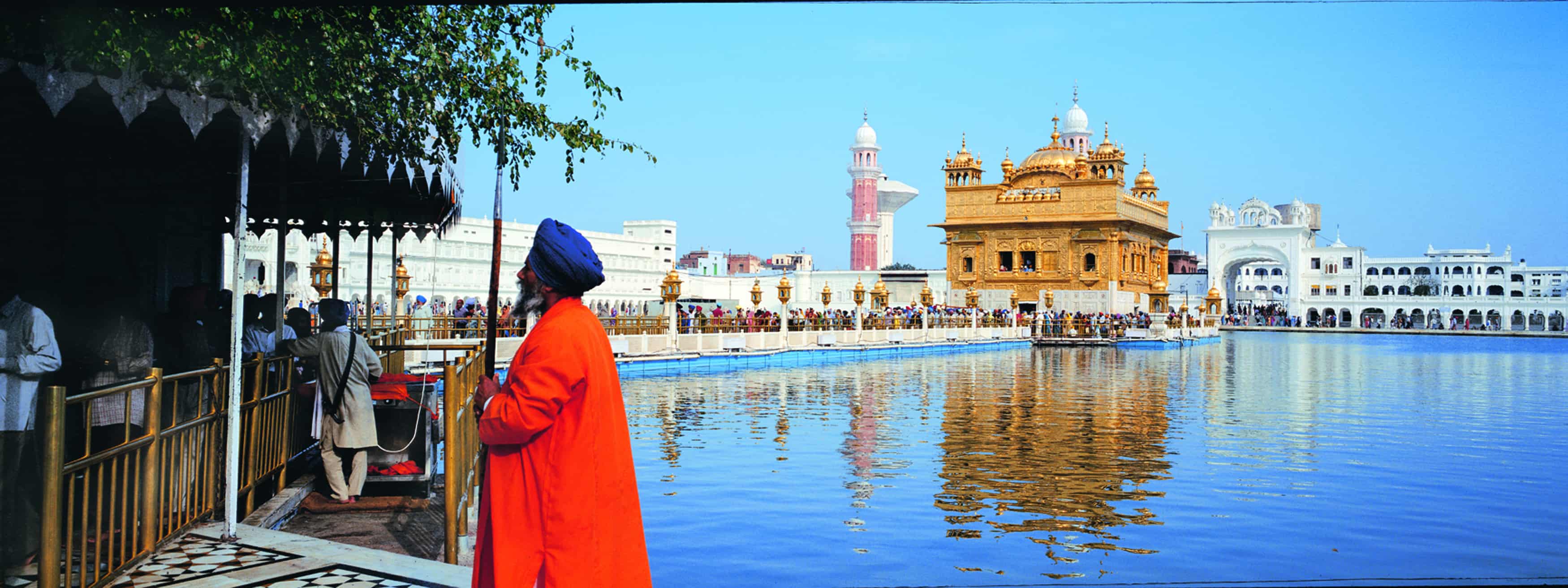 India Tourism
India TourismBy Judi Lees
It is a misty morning on the Ganga River in Varanasi. As the sun sheds its early golden glow we sit in a boat to float a small candle and flower in the dark, wide water. Ghats – places of worship – border the shoreline and hundreds of Hindus are on wide steps or waist deep in the water chanting the Gayatri Mantra, an important and ancient Hindu prayer that some believe dates back 6,000 years.
Eighty-three per cent of India’s population of 1.15 billion people are Hindus, however, there are also followers of Buddhism, Christianity, Jainism and many more faiths in this culturally rich country. Since visiting sacred places is a burgeoning market in tourism today, here are some highlights of India’s major religions and pilgrimage sites.
Hinduism
Hinduism is based on the four Vedas, the world’s most ancient scriptures. Hindus believe in karma, that each individual creates his own destiny and they believe in reincarnation. The religion encompasses every aspect of daily life.
Pilgrimmage Places: Allahabad, Haridwar, Varanasi, Vrindavan, Puri, Tirumala-Tirupati, Katra-Vaishno Devi Temple, Rameswaram, Dwarka, Mahabalipuram, Kanchipuram, Tanjore, Trichy, Madurai.
Festivals: Holi, Dussera and Diwali.
 India TourismBuddhism
India TourismBuddhismBelieved to be the world oldest religion, it is based on the teachings of Siddhartha Gautama, known as the Buddha.
The basics of Buddhism include the Middle Way (following a path of moderation) and the Four Noble Truths (the fact that life means suffering and how this should be handled) and meditating to reach Nirvana. Today between 360 and 500 million people are followers and about three per cent of Indians are Buddhist.
Pilgrimage Places: Bodhgaya, Sarnath, Kaushambhi, Nalanda, Shravasti, Kushinagar, Rajgir, Vaishali
Festivals: Buddha Poornima
 Christianity
ChristianityThe roots of Christianity run deep in Indian culture, dating from 52, when St. Thomas, one of Jesus’ 12 apostles, arrived and spent 12 years preaching the word of God. The apostle arrived in southern India and even today the majority of Indian Christians – about 2.3 per cent of the population – live there, however, there are many places of worship of all denominations throughout India. India’s most famous Christian, Nobel Peace Prize winner, Mother Teresa, was born in Albania but became an Indian citizen and made her life work in Calcutta.
Pilgrimage Places: Basilica of Bom Jesus, Church of St Cajetan, Church of the Sacred Heart, Santa Cruz Basilica, Cathedral Church of St Thomas, Little Mount, Basilica of Our Lady of Good Health
Festivals: Easter, Christmas
Jainism
One of the many doctrines of Jainism is to regard every living being as you do yourself – in other words, be kind to others. The members of this faith – 3.2 million in India – that dates back to the 6th century believe in non-violence, controlling your mind and senses and that you are the master of your own destiny. They believe in karma and meditation as means to enlighten and free the soul however, because of stringent rules such as celibacy, the “great vows” are utilized by monks and “limited vows” are prescribed for ordinary citizens.
Pilgrimage Places: Palitana, Ranakpur, Sravanabelagola, Dilwara Temple, Khandagiri Caves, Undaygiri Caves
Festivals: Festival of Navpad Oli, Diwali
Islam
With a history dating back to the 12th century in India, there are close to 150 million devotees of Islam. Their beliefs are based on the Quran; there are six Articles of Faith – the first stating that Allah is God – and they follow the Five Pillars of Faith, rituals that must be adhered to as part of their religion. Islam is the second-most practiced religion in India, with more than 13.4 per cent of the population adhering to its beliefs.
Pilgrimage Places: Jama Masjid-Old Delhi, Ajmer Sharif, Haji Ali-Mumbai, Fatehpur Sikri, Moti Masjid-Bhopal
Festivals: Ramadan

Sikhism
This unique Indian religion was founded by Guru Nanak in northern India some 500 years ago. The followers live under the guidelines of the Holy Granth, the writings of 10 gurus who followed Guru Nanak. Sikhs, easily recognized by the turban-wearing men, believe in one God, karma and reincarnation. They negate the caste system of the Hindu belief and they do not go on pilgrimages or fast and take part in rituals. About two per cent of India’s population is Sikh, mostly living in Punjab.
Pilgrimage Places: Hari Mandir (Golden Temple), Five Takhts, Anandpur Sahab
Festivals: Baisakhi, Hola Mohalla
Zoroastrianism
Parsis, followers of Zoroastrianism, number around 90,000 in India and most are settled in Mumbai. Founded perhaps as early as the 6th century in Persia (Iran), the religion believes in one God. It teaches that fire, water, air and earth are sacred and therefore the dead are not buried or cremated but simply left in a high tower – Tower of Silence – to disintegrate. While this sounds heathen, many Parsis have been instrumental in developing modern Indian industry.
Pilgrimage Places: Sanjan
Festivals: Sadeh
Judaism
Jewish traders arrived on the southeast coast about 2,500 years ago, first settling in Cranganore. Today, the majority live in Mumbai, Mizoram and Manipur. The Manipur Jewish community considers itself to be the descendants of the Manasseh (Menashe) Tribe, one of the 10 lost tribes.
Pilgrimage Places: Synagogue of Mattancherry, Pardesi Synagogue, Tifereth Synagogue, Magen David Synagogue, Neveh Shalome Synagogue
Festivals: All of the traditional Jewish festivals are celebrated
Animism
Not a religion itself, Animism can be found in the believes of many religions around the world. In India the tribal cultures, found mainly along the Himalayas, in the hilly areas of central India and scattered throughout western and southern India believe spirits live not only in humans, but in the natural world around us.
For more information on pilgrimage travel in India, contact Indiatourism, Toronto at info@indiatourismcanada.ca, or visit www.incredibleindia.org


